Any film photography lover knows that photographic film conveys a sense of realness and gravity that digital cameras have a difficult time recreating. But many photographers are hesitant to work with film because of the belief that you need a darkroom to develop it.
Darkrooms are used to make prints from film negatives and are not required to develop film since film can be easily developed at home using a film developing tank, film developing chemicals, and a film changing bag along with items found in your home. Other options for developing film include drugstores, film labs, and community darkrooms.
So, it’s entirely possible to develop film in the comfort of your own home without a remodeling job. But how does at-home film developing hold up to mailing it out to an online lab or going into the store? Let’s explore this topic more to see the best way to bring your images to life.
Developing Film Without a Darkroom
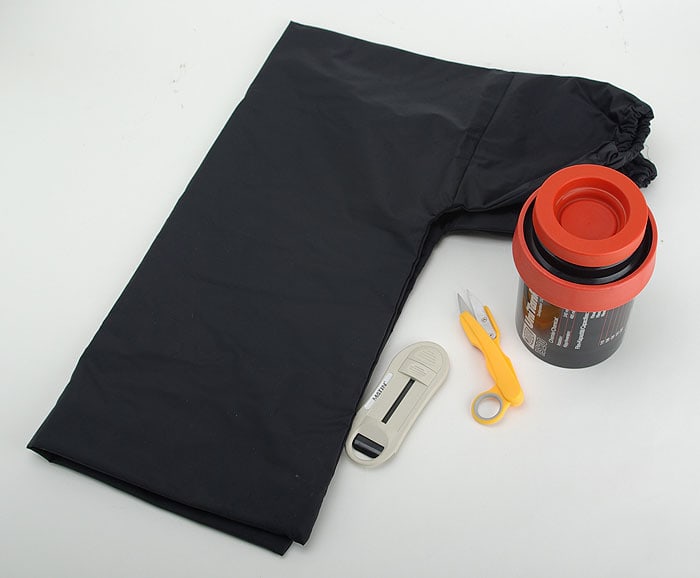
With a few pieces of specialized equipment, film development at home becomes pretty straightforward and entirely possible. Here’s what you need:
- Developing tank: This holds the film and chemical mixtures as the image develops on reels. These tanks act similar to a darkroom and are light-proof.
- Bottle Opener: To open the 35mm film canister.
- Scissors: To cut the film off of the 35mm or medium format film roll.
- Metal, Glass, or Plastic stirrer: This is used to combine the chemicals when mixing and should only be either glass, metal, or plastic.
- Changing bag: that facilitates the transfer of the film from the roll or film canister to the developing tank without being exposed to light.
- Developing Chemicals (see below): These convert latent images on the negatives to visible ones. You will need different chemicals for color and black & white films.
- Thermometer: Used to track the temperature of chemicals. This should be waterproof and separate from other uses.
- Large Container for Water or a Sink: This is used as a water bath to raise or lower the temperature of the developing chemicals, if needed.
- Measuring Cups / Graduated Cylinders
 : These can accurately measure amounts of chemicals required for mixing and pouring into the development tank
: These can accurately measure amounts of chemicals required for mixing and pouring into the development tank - Timer (on your phone or a seperate device): This tracks how long the film has been developing.
- Film clips or clothespins: These are used to air dry developed films. These are more efficient than traditional clothespins.
- Plastic Funnels: This is used to pour the developing chemicals into the developing tank, graduated cylinders, mixing bottles, or storage bottles.
- Bottles to Mix and Store Developing Chemicals: These bottles are used to mix and store chemicals for later uses once you mix it. This keeps chemicals at their full functional capacity.
With these pieces of equipment, you are all set to begin the fun part. Interested in learning the simple process? See this article for how to develop black and white film at home and this article for how to develop color film
at home and this article for how to develop color film at home.
at home.
Once you purchase the development tank with reels, plastic funness, measuring cups, thermometer, clothespins, bottles to mix and store chemicals, and changing they can used repeatedly, if taken care of. Plastic reels, like the one listed above, although easier to use at the beginning than metal ones, will eventually need to be replaced because it can accumulate the chemicals overtime (over 10 years or so). The only items that will need to be repeatedly bought after these items would be your film and chemical developer. But a single container of developer can be used to develop 25 or more rolls before needing to be replenished.
Darkroom are used to make a print from your photographic film so rather than creating an entire darkroom (see this article for tips on setting up a darkroom
so rather than creating an entire darkroom (see this article for tips on setting up a darkroom at your house), assembling this “mini-lab” is all you need. It’s cheaper and requires less space.
at your house), assembling this “mini-lab” is all you need. It’s cheaper and requires less space.
Iford Pop-Up Darkroom
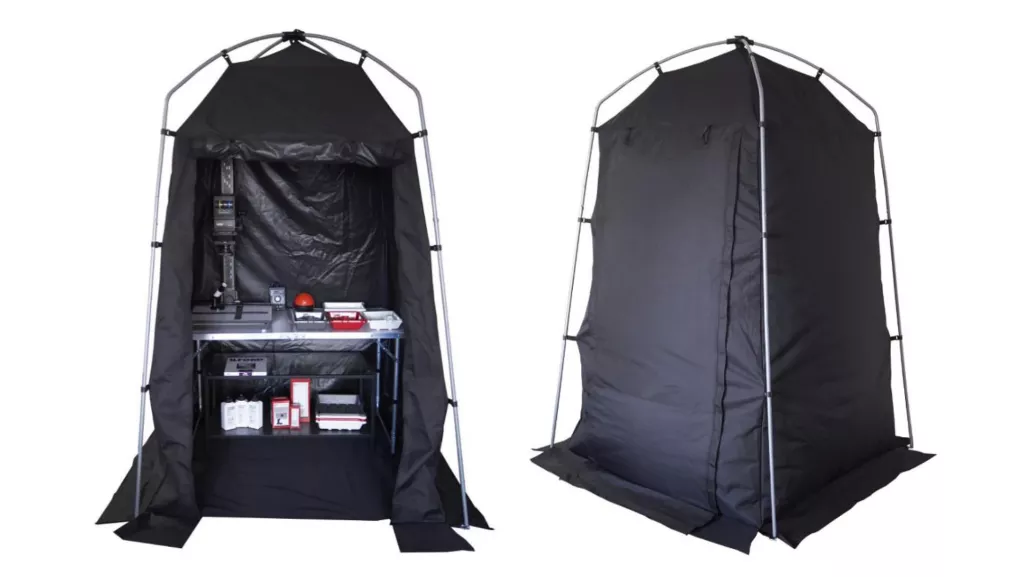
The darkroom company giant, Ilford Harmon, recently announced a new portable pop-up darkroom that is basically a tent that is light tight and can easily be set up and taken down in which you can make prints or develop film. The pop-up darkroom will be 7.2 ft (2.2m) tall and has a space inside of 4.2ft x 4.2ft (1.3m x 1.3m) which is big enough for a table for your enlarger and chemicals so you can develop film or make prints. It has a protective mat so it won’t ruin your floors if used indoors. It also has a built-in air vent at the top and bottom to help with air circulation.
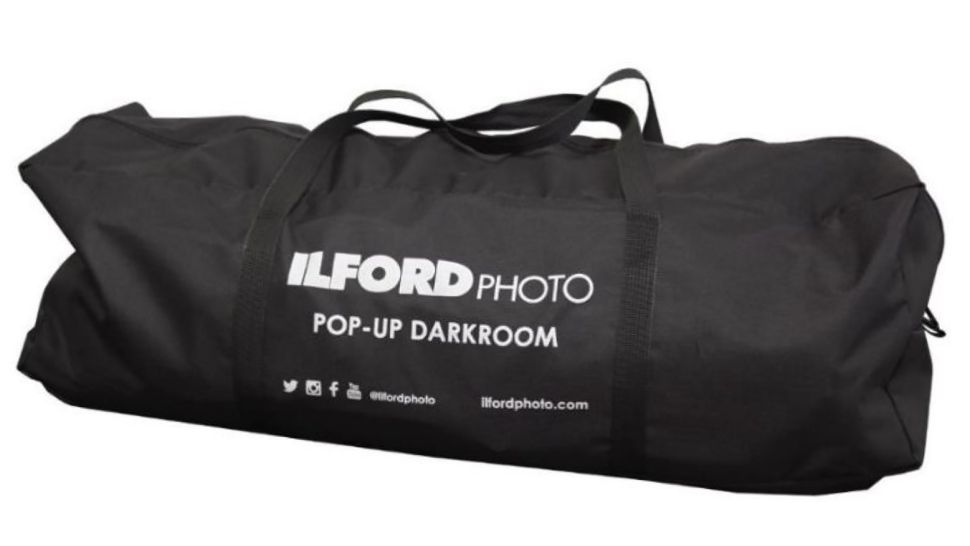
The entire thing fits in the supplied storage bag and measures 26.6in x 9.8in x 9.8in (68cm x 25cm x 25cm) and weighs 17.5lbs (8kg). The pop-up darkroom will go on sale in November of 2021 and will cost around $265 USD. See this website for more information.
for more information.
Ilford recently also announced a darkroom starter kit in partnership with the company Paterson that offers everything that is needed to make a print, except for an enlarger and a safelight. This will cost around $150 USD and includes the following:
- 1 x Ilford Multigrade RC Deluxe Pearl Paper 8×10” 25 sheet box
- 1 x Ilford Multigrade Developer 500ml bottle
- 1 x Ilford Ilfostop 500ml bottle
- 1 x Ilford Rapid FIXER 500ml bottle
- 1 x Paterson 1200ml Graduate Cylinder
- 1 x Paterson 150ml Graduate Cylinder
- 1 x Paterson Chemical Mixer
- 1 x Paterson Thermometer Small (9”)
- 3 x Paterson 8×10 Trays (Red / White / Grey)
- 3 x Paterson Print Tongs (Red / White / Grey)
- 1 x Paterson Micro Focus Finder
What Chemicals Do I Need to Develop Film?
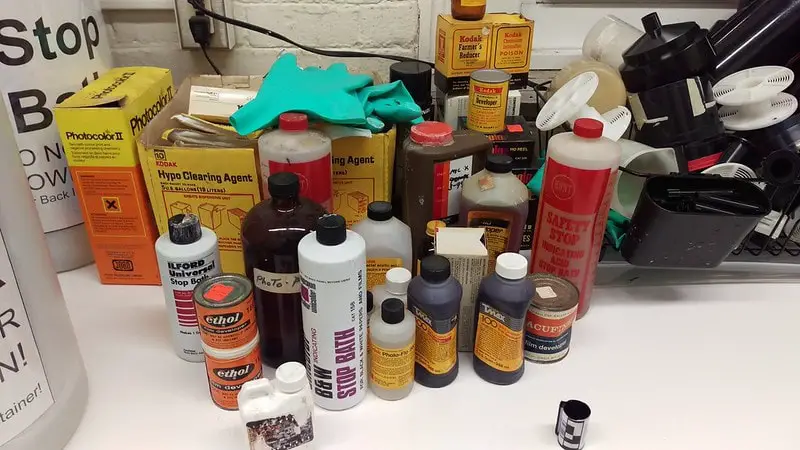
When developing film at home, the type of film you are developing dictates the type of solution you need.
- For colored films, we recommend CineStill film’s C41 “Color Simplified” solution. It’s affordable and does not require anything additional other than the film and developing tank. It is a straightforward process, and has all the chemicals you need to get started.
- For black and white films, we recommend CineStill film’s DF96 “Developer & Fix” Monobath solution
 . It’s one of the fastest developing solutions on the market and can develop film in only 3 minutes without multiple chemicals to keep track of. Not only is it effective, but it’s also affordable for beginners. Keep in mind that you do need to follow the directions precisely in regards to develop time and temperature
. It’s one of the fastest developing solutions on the market and can develop film in only 3 minutes without multiple chemicals to keep track of. Not only is it effective, but it’s also affordable for beginners. Keep in mind that you do need to follow the directions precisely in regards to develop time and temperature with specific films and ISOs.
with specific films and ISOs.
These solutions are our top choices for beginners because of how simple they are use. They are all-in-one solutions that require minimal measuring and mixing — meaning that it will be quicker and less prone to error. All you need to do is mix these chemicals with water, and they are ready to be used. These solutions are designed to be easy for beginners and it holds true.
For more information about chemicals used in the darkroom and how to handle them safely see this article.
see this article.
Is Developing Film at Home Dangerous?
Even though chemicals are used in the developing process, developing film at home is not dangerous. The chemicals typically used for black & white are classified as toxic but only when consumed or in come into contact with your eyes or skin.
Chemicals used for developing color film are considered more toxic than black & white film so they should be handled with more care. Provided that you approach the chemicals with common sense and follow the manufacturer’s directions, you will be just fine.
and follow the manufacturer’s directions, you will be just fine.
Here are a few things to keep in mind when working with darkroom chemicals:
- Don’t inhale them more than necessary. Work in a room with vents or windows, as fumes may potentially irritate a person with pre-existing conditions like asthma.
- Wear gloves, goggles, and apron, and long sleeves. Don’t let chemicals touch bare skin or get into your eyes.
- Dispose of darkroom chemicals properly. Darkroom chemicals cannot be discarded down the sink like other liquids, as they will damage your plumbing, septic system (if you have one), and can harm the environment
 .
.
If you follow basic safety protocols, working with developing chemicals isn’t dangerous at all. See this guide for more information about darkroom chemicals , how to handle them safely, and how to dispose of them correctly.
, how to handle them safely, and how to dispose of them correctly.
How to Properly Dispose of Darkroom Chemicals
To properly dispose of chemicals, first, thoroughly read the label and directions for your specific darkroom chemical. More often than not, local waste management companies are available and will work with you to dispose of chemicals. Call them and ask about how their procedures work.
If waste management is not available, you may be able to get away with diluting the chemical with water and pouring it down your drain. Of course, it really depends on the instructions on the chemical itself. Follow as instructed as accurately as possible.
See this article for more information about disposing used darkroom chemicals .
.
Developing Film With Safer Chemicals
There are a several ways to develop film with chemicals that are more environmentally safe and safer for the photographer. For example, the company LegacyPro makes film developing chemicals (for black & white film and darkroom paper) which are free of known carcinogens and mutagens.
makes film developing chemicals (for black & white film and darkroom paper) which are free of known carcinogens and mutagens.
There are also ways to develop film using liquids found around your home like coffee, beer, and wine. See this article , if you are interested in developing film at home using more environmentally safer chemicals.
, if you are interested in developing film at home using more environmentally safer chemicals.
Where Can I Get Film Developed?
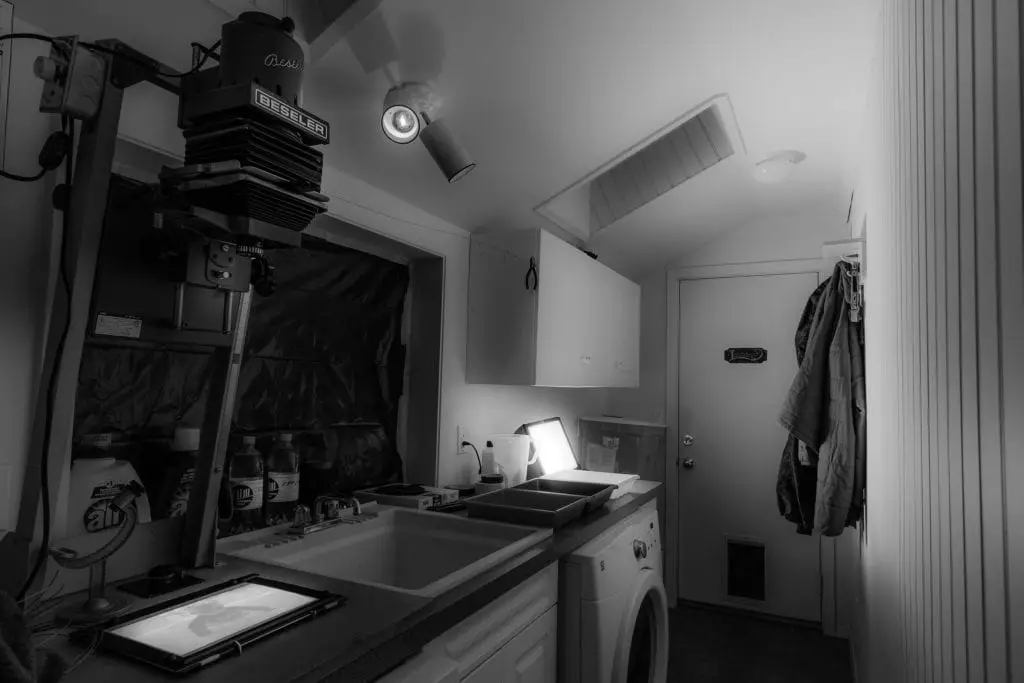
Besides developing film at home, there are both brick-and-mortar physical options and online services through the mail. There may even be local professional or community darkrooms near you if you live in a large city like New York City or Charlotte, NC
or Charlotte, NC that you can use for free of charge or darkrooms for rent, provided that you bring your own supplies. See this website to locate a darkroom near you
that you can use for free of charge or darkrooms for rent, provided that you bring your own supplies. See this website to locate a darkroom near you . With many options, there’s really no excuse to finally get those films developed once and for all.
. With many options, there’s really no excuse to finally get those films developed once and for all.
Local Drugstores that Can Develop Film
Several big chain businesses still continue to develop film. See this guide for more information about where to develop film near you but in general your best options are Walmart, CVS, and Walgreens. However, keep in mind you don’t get your negatives back with all three options and they will take much longer than getting your film developed through the mail.
but in general your best options are Walmart, CVS, and Walgreens. However, keep in mind you don’t get your negatives back with all three options and they will take much longer than getting your film developed through the mail.
See below for more information about each store:
Walmart
At Walmart it costs $9.96 for a 24 exposure roll and $13.96 for a 36 exposure roll of 35mm film to get developed and includes prints and scans but you won’t get your negatives back. This store is the cheapest but it has the longest turnaround of all three and the scans are low quality. See this article for more information about developing film at Walmart like what film Walmart can process, how to get film developed, and the cost.
like what film Walmart can process, how to get film developed, and the cost.
CVS
At CVS it costs $14.42 for a 24 exposure roll and $16.99 for a 36 exposure roll of 35mm to get developed and includes prints and scans. This store has the best quality scans with a long processing and you won’t get your negatives back. See this article for more information about developing film at CVS like what film theycan process, how to get film developed, and the cost.
Walgreens
At Walgreens it costs $14.99 for a 24 exposure roll and $17.99 for a 36 exposure roll of 35mm film with scans and has the one of the fastest turnaround times between the three choices (still about a month) but again, you don’t get back your negatives. See this article for more information about developing film at Walgreens like what film they can process, how to get film developed, and the cost.
like what film they can process, how to get film developed, and the cost.
Options for Developing Film Through the Mail or In Store
See t his guide about where to get your film developed near you or through the mail
his guide about where to get your film developed near you or through the mail  for more specific information but in general these are the best places I have found so far:
for more specific information but in general these are the best places I have found so far:
- The Darkroom
 — For $17.95 (including shipping) per roll, they will develop your color and black & white 35mm and medium format film. You download a shipping label from their website and mail in your film. They will process the film, send you digital scans, and will send the negatives back to you via mail.
— For $17.95 (including shipping) per roll, they will develop your color and black & white 35mm and medium format film. You download a shipping label from their website and mail in your film. They will process the film, send you digital scans, and will send the negatives back to you via mail.
- OldSchoolPhotoLab.com
 — For $19.79 (including shipping) per roll, they will develop your 35mm and medium format color film and for $21 they will develop your black & white 35mm and medium format film. You download a shipping label from their website and mail in your film. They will process the film, send you digital scans, and will send the negatives back to you via mail.
— For $19.79 (including shipping) per roll, they will develop your 35mm and medium format color film and for $21 they will develop your black & white 35mm and medium format film. You download a shipping label from their website and mail in your film. They will process the film, send you digital scans, and will send the negatives back to you via mail.
- Mpix.com
 — For $17.90 (including shipping) per roll, they will only develop your color 35mm and for medium format film. You send them your film and they will process your film and upload your scans online. Then, they’ll send the negatives back to you via mail.
— For $17.90 (including shipping) per roll, they will only develop your color 35mm and for medium format film. You send them your film and they will process your film and upload your scans online. Then, they’ll send the negatives back to you via mail.
If you only want your film to be developed but not scanned the prices go down around $4 – $5 but this differs which each company.
Community Options for Film Developing
Local darkrooms are a great option and may provide access to facilities for a membership fee or per-use cost. Companies like The Portland Darkroom , The Bushwick Community Darkroom,
, The Bushwick Community Darkroom, and The Asheville Darkroom
and The Asheville Darkroom are cropping up across the country. College campuses are a great starting point, as they may have darkrooms accessible to the community as well.
are cropping up across the country. College campuses are a great starting point, as they may have darkrooms accessible to the community as well.
At Home Development vs. Mailed Out vs. Retail Store Development
Now you know all the various methods to develop film, is there one that reigns supreme? Let’s find out.
Developed Where | Average Cost Per Roll | Average Time | Scans Quality | Scans Returned? |
|---|---|---|---|---|
Cost To Develop Film at Home | $5.98 (b & w) – $6.30 (color) | 5 hours | Average – Professional | Yes, because you did it! |
Cost to Develop Film Through the Mail With Online Lab | $20 per roll | 5-7 days | Professional | Yes |
Cost to Develop Film At Drugstore | $20 per roll | up to 4 month | Low quality Scans | No |
When considering average costs, it is more expensive up front to develop film yourself at home, but you save money develop film over time after the initial investment. If you are willing to pay the upfront cost for everything you need to develop film at home including the chemicals (about $149.74 for black & white and about $157.73 for color chemicals, without shipping and taxes). On average, it costs $6.14 to develop 25 rolls of film since that is how many rolls each bottle of chemicals that I recommended can process. It also gets less expensive over time considering all you will need replenish of your supplies is film and development chemicals. After the initial purchase, the average cost goes down even further to $0.80 ($20 / 25 rolls) for black & white film and $1.11 ($27.99 / 25 rolls) since all you will need to purchase are the development chemicals.
including the chemicals (about $149.74 for black & white and about $157.73 for color chemicals, without shipping and taxes). On average, it costs $6.14 to develop 25 rolls of film since that is how many rolls each bottle of chemicals that I recommended can process. It also gets less expensive over time considering all you will need replenish of your supplies is film and development chemicals. After the initial purchase, the average cost goes down even further to $0.80 ($20 / 25 rolls) for black & white film and $1.11 ($27.99 / 25 rolls) since all you will need to purchase are the development chemicals.
Even with the initial investment in mind, it is clear that at-home development costs more initially but much less over time than retail or using an online lab. However, professional quality scans from an online lab might be worth the cost to you.
See this article for more information about how to develop black & white film or how to develop color film
or how to develop color film at home.
at home.
Wrap Up
While it most likely would have been impossible to develop film at home decades ago, that is no longer the case. With the creation of equipment like the developing tank, changing bag, and powdered chemicals, you can mimic the properties of a darkroom at the convenience of your own home.
In fact, developing film at home is more convenient and cheaper, even compared to traditional methods. Whether you found an old roll of film lying in the cabinet or you’re an avid film photographer, go out and take some pictures. Film development is possible even without a traditional darkroom.

